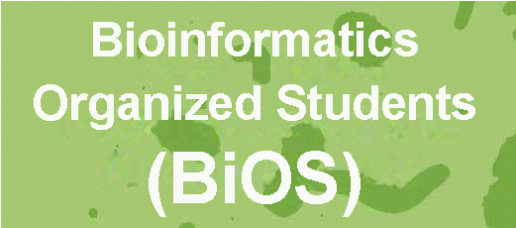Spring 2022 Student Seminars
January 19
Ahmed Youssef
Advisor: Andrew Emili
Title: Deconvolution of Bulk Proteomics Using Single-Cell Sequencing Data
Abstract:
The fundamental unit of all living organisms is the cell, and recent technological advances have granted us unprecedented opportunities to study life at this principal level. Proteins, through their networks of interactions, carry out most of the vital biological processes governing cellular functions, yet remain largely unexplored at the resolution of single cells, representing crucial gaps in our knowledge of cell biology. While there remain challenging technical hurdles to overcome for experimentally measuring proteins on a systems-wide scale at the level of individual cells, single-cell RNA sequencing (scRNA-Seq) has emerged in recent years as a powerful technology for defining cell states on a large scale, enabling breakthroughs in many areas of cell biology research, and raising the question of whether this type of data can be used for making inferences at the protein level. This presentation proposes a method for developing computational approaches for studying protein states and interactions at the single-cell level, providing a framework for studying the impact of diseases on molecular function in a manner that enables the development of targeted therapies. A novel deconvolution algorithm is proposed that combines scRNA-Seq data with global protein measurements within a regression framework that enables the modeling of the global proteome at the single-cell level. A case study on cells undergoing EMT is presented alongside preliminary results for the algorithm.
Rebecca Panitch
Advisors: Lindsay Farrer & Gyungah Jun
Title: Understanding the Mechanisms and Pathways of Alzheimer’s Disease in APOE Genotype Sub-Population
Abstract:
The APOE ε4 allele is the strongest genetic risk factor for late onset Alzheimer disease (AD) and the ε2 allele is known to mitigate risk of AD. AD-related neurological and clinical traits have shown specific patterns depending on an individual’s APOE genotype. We investigated APOE genotype specific transcriptomic and methylation changes in both blood and brain to identify genes and biological pathways underlying the risk and protective mechanisms in AD.
February 2
Conor Shea
Advisors: Marc Lenburg and Avrum Spira
Title: Epithelial, stromal, and immune changes associated with lung squamous premalignant lesion severity identified by single-cell RNA-seq
Abstract:
Bronchial pre-malignant lesions (PMLs) are the putative precursors for bronchial squamous cell carcinoma. PMLs represent a spectrum of histologies, from low-grade lesions (hyperplasia, metaplasia) and high-grade lesions (dysplasia, carcinoma in situ). The majority of these lesions will regress or remain stable without clinical intervention while a subset of lesions will progress to invasive carcinoma. We performed single-cell RNA sequencing (scRNAseq) of these lesions to elucidate the cross-talk between epithelial, stromal, and immune populations in lesions of increasing histological grade. We observed expected smoking related shifts in epithelial cell type proportions, including an increase in secretory cells and a decrease in ciliated cells among current smokers. Distinct differences in expression of transcriptional modules were observed between KRT5+ (basal) cells from different histologic grades. Basal cells from high grade lesions expressed smoking detoxification and cell cycle gene programs, while low grade lesion basal cells expressed differentiation gene programs. We also identified a group of cells from CIS lesions involved in an epithelial-to-mesenchymal transition, marked by an increase in SPARC and COL4A1 expression and a decrease in CDH1 expression. Subpopulations of immune cells identified include macrophages, CD4/8+ T, B, dendritic cells, and natural killer cells. Several clusters of CD4+ and CD8+ T cells displayed an exhausted phenotype, marked by the expression of PD-1, CTLA4, LAG3, and TIGIT. Samples with high grade histology (dysplasia, carcinoma in situ) were enriched in CD4+ Tregs and myeloid cells compared to low grade histology samples (hyperplasia, metaplasia), which were enriched in Natural Killer and cytotoxic CD8+ T cells. Our results suggest that changes in specific transcriptional programs are associated with the transition of epithelial cells to more invasive states and that changes in immune populations are associated with increasing histological grade. These signatures can suggest novel avenues for chemoprevention and cancer interception.
February 16
Devlin Moyer
Advisors: Juan Fuxman Bass & Daniel Segrè
Title: Using Expression Data To Make Context-Specific Metabolic Models
Abstract:
Dysregulated metabolism has been recognized as one of the hallmarks of cancer. Relatedly, many chemotherapies have been designed to target the unique metabolic requirements of cancer cells. However, there is extensive heterogeneity in the response to treatment amongst cancer patients and even between patients with the same type of cancer. Developing a deeper understanding of the metabolic disruptions in tumors in a patient-specific manner can provide insight into this heterogeneity and pave the way for the development of personalized therapeutics. Direct measurement of metabolic fluxes using metabolomics and isotope tracing is expensive and time consuming and thus challenging to apply to large cohorts of patients. I will circumvent this limitation by using Genome-Scale Metabolic Models (GSMMs) — a mathematical framework for predicting metabolic fluxes in a given metabolic network — and readily available cancer genomic and transcriptomics datasets to simulate metabolic disruptions in cancer cell lines and patients. By grouping patients based on simulated metabolic phenotypes and simulating the effects of administering various real and hypothetical treatments, I will identify common and patient-specific metabolic vulnerabilities that can be targeted for treatment purposes. By leveraging databases of existing drugs and their targets, I will use these models to predict patient-specific responses to specific metabolic therapies and experimentally validate them using patient-derived tumor xenografts. Altogether, the results of this work will provide a valuable framework for future studies of cancer metabolism and provide a novel pipeline for predicting effective cancer treatments.
Rebekah Miller
Advisor: Trevor Siggers
Title: Profiling COF Recruitment and Transcription Regulation Using an Array-Based Approach
Abstract:
Regulation of gene transcription is critical to the correct functioning of a cell, and its dysregulation can lead to disease. The set of transcription factors (TFs) and associated cofactors (COFs) that are present in a given cell type determine which genes are transcribed in that cell. TFs bind to specific DNA sequences found in regulatory regions known as enhancers and recruit specific COFs to these loci. The COFs then establish and maintain epigenetic modifications, such as histone acetylation and methylation marks, that affect the transcription of genes associated with that enhancer. We have developed a novel protein binding microarray-based approach (CoRec) to determine COF recruitment preferences in a cell-type specific manner, and we are planning to integrate these results with genomic data to examine how the genomic localization of these proteins affects the epigenome and ultimately regulates gene transcription.
March 2
Mengze (Vanessa) Li
Advisor: Stefano Monti
Title: yQTL pipeline design and QTL discovery in New England Centenarians Study
Abstract:
Quantitative trait loci (QTL) refer to DNA sequence variants, such as SNPs, that influence the level of a quantitative trait. Common examples influence genetic loci that influence the gene expression level, usually mRNA, and protein and molecular metabolites abundance. They are referred as eQTL, pQTL and mQTL, respectively. The term “yQTL” is used in my project to denote a generalized form of a QTL, where the dependent variable y can be any of a wide range of molecular markers, either directly measured (e.g., gene expression or protein abundance), or inferred (e.g., gene set enrichment score). My project aims to discover of yQTLs related to human longevity markers. By analyzing the molecular information of people with extreme longevity, sets of longevity markers can be identified, including mRNAs, proteins, and metabolites. QTLs for those molecular traits can then be discovered. Currently, pQTL and mQTL discovery on datasets from New England Centenarians Study (NECS) is being done.
QTL discovery is a complex and computationally intensive process since it requires several processing steps, such as quality control of input genetic data, running association test on a large number of phenotypes, and post-processing of the QTL results. To tackle this problem, another part of my project is to develop a yQTL discovery pipeline using Nextflow to achieve an automation of the analysis process as well as the parallelization of computational tasks.
March 16
Kathryn Atherton
Advisors: Jennifer Bhatnagar & Daniel Segrè
Title: The Soil Network: Understanding how urbanization impacts microbial interactions
Abstract:
Across the globe, urban areas are rapidly growing in size, but the impact of urbanization on ecosystem complexity is unknown. Urban trees have been found to grow faster and die younger than rural trees, while the soil microorganisms that support their growth have lower overall biodiversity and abundance in urban ecosystems. My research tests the hypothesis that urbanization disrupts interactions within the soil microbiome which inhibits nutrient exchanges between soil microbes and trees. To test this hypothesis, I am first quantifying species associations within soil, root, and leaf microbiome of trees from Boston into western Massachusetts. I am building co-occurrence networks for tree microbiomes I measured from 37 street trees within the city of Boston and 54 trees across 8 forests within the Urban New England study system in summer 2021. I am then developing a computational tool for automatically validating predicted interactions using genomic databases and existing literature. I plan to apply this tool to validate changes in species association networks along the gradient. My data will be used to support the City of Boston’s Urban Forest Plan for maintaining the city’s trees.
Yusuke Koga
Advisor: Joshua Campbell
Title: Replication of lung function decline signatures in a novel RNA-seq cohort
Abstract:
Chronic Obstructive Pulmonary Disease (COPD) is among the world’s most prevalent diseases, causing roughly 3 million deaths globally per year. Smoking is one of the strongest risk factors for COPD and creates a “field of injury” throughout the airway epithelium. We have previously identified bronchial gene expression signatures associated with lung function decline phenotypes using microarrays to profile bronchial brushes from participants in the British Columbia Lung Health Study (BCLHS). In this study, we aimed to validate these signatures in bronchial and nasal brushings from an independent cohort profiled with RNA sequencing. RNA-seq data was generated from bronchial brushings collected from current and former smokers. Associated differential gene expression was ascertained by linear modeling, and enrichment of these previous bronchial signatures were determined through Gene Set Enrichment Analysis (GSEA). The bronchial gene expression signatures were concordantly enriched amongst genes most strongly associated with lung function decline phenotypes within our cohort. (q-val < 0.05) These results demonstrate the robustness of the bronchial lung function decline signatures and may be further leveraged to further understand COPD pathogenesis.




